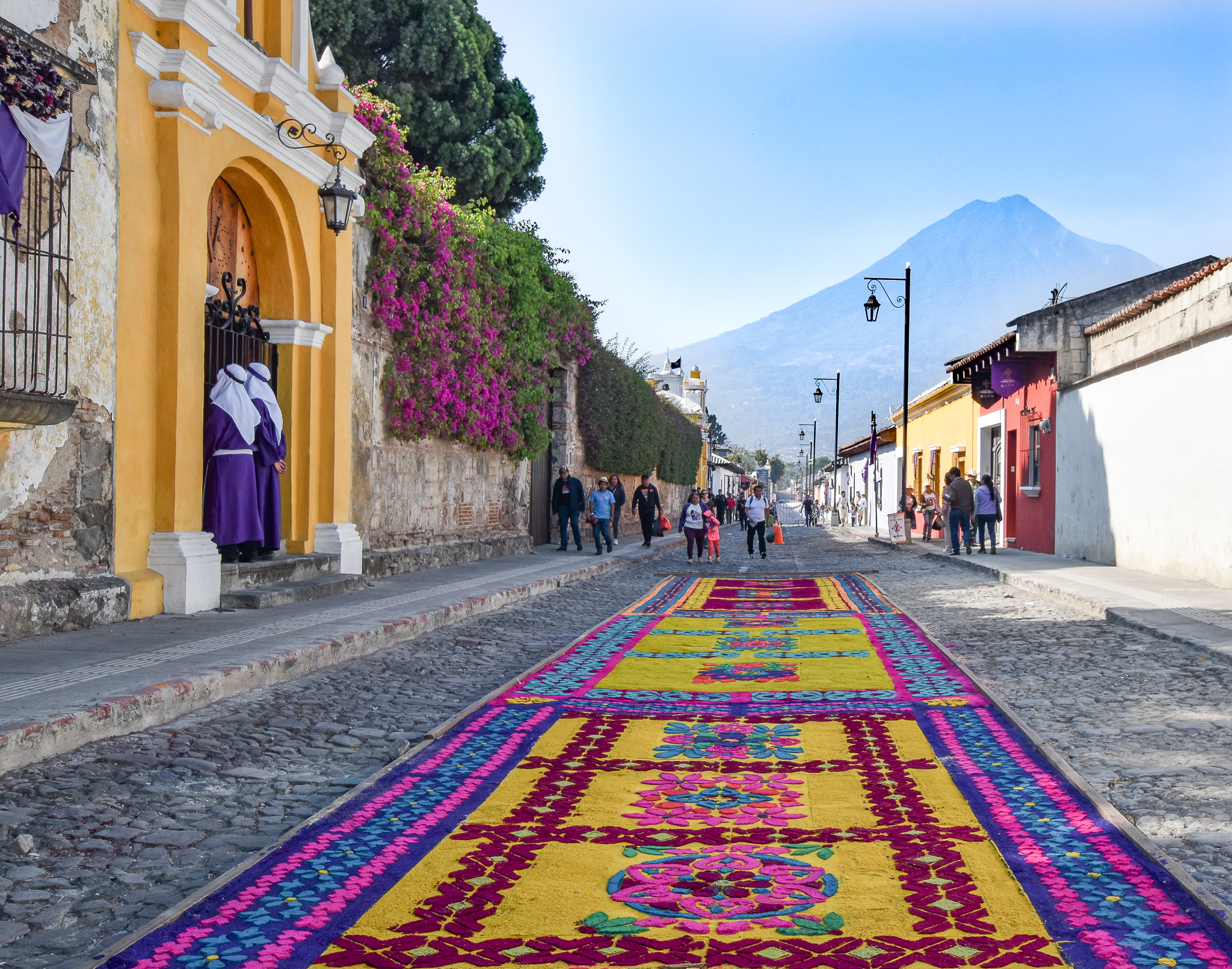
I finally prepared my itinerary for Guatemala — three days in Flores, to see the Mayan pyramids in the jungle; and then five days in Antigua, the most exquisite town in the country, surrounded by volcanos. From there, I would go to Lake Atitlán for one day.
While I was eager to see Guatemala and knew it would be beautiful, there was something rather ordinary about the itinerary. Every tourist goes to those places, and their photos are all over the social media. The only extraordinary twist in my planning was that I could not find any available hotel or guesthouse in Antigua itself. It meant crowdedness, of course, which gave me a pause. But I ended up biting my tongue and booked the last place on offer — a small cottage in the backyard of a house in the village of San Juan del Obispo, outside Antigua. It turned out that the lack of beds had its reason. I accidentally scheduled my trip exactly for the busy week of Easter.

Once I was in Guatemala and saw the festivities, my planning concerns went away. Easter there is not just a prominent mark on the Catholic calendar; it is an occasion which brings locals together. And they celebrate in such a spectacular way that even an agnostic like me can appreciate it. Some of the Easter traditions came from Spain, but as with everything in Guatemala, they were meshed into the country’s Mayan traditions.
Easter on an island
Petén is the vast northern plain of Guatemala, which juts out from the rest of the country if you look at the map. There, a tropical jungle hides the world-famous sites of the ancient Mayan civilization. Under the canopies of tall trees, there are pyramids, palaces, game courts, and other impressive structures made of stone.

I had time to visit two of those archeological sites, Tikal and Yaxha. The day tours to reach them begin in the town of Flores, in the middle of Petén. I had thought that Flores would feel like a sleepover place unworthy of note, but it turned out to be a pretty and colorful town on a small island on the lake of Petén Itzá.
To get a break from the humid jungle heat, I asked a gentleman with a motorboat whether he would take me around Flores. We breezed on the water, but the scenery remained the same. The island is round and the postcard look of the town is symmetrical—brightly painted houses on a hill that is capped with the white towers of a church.
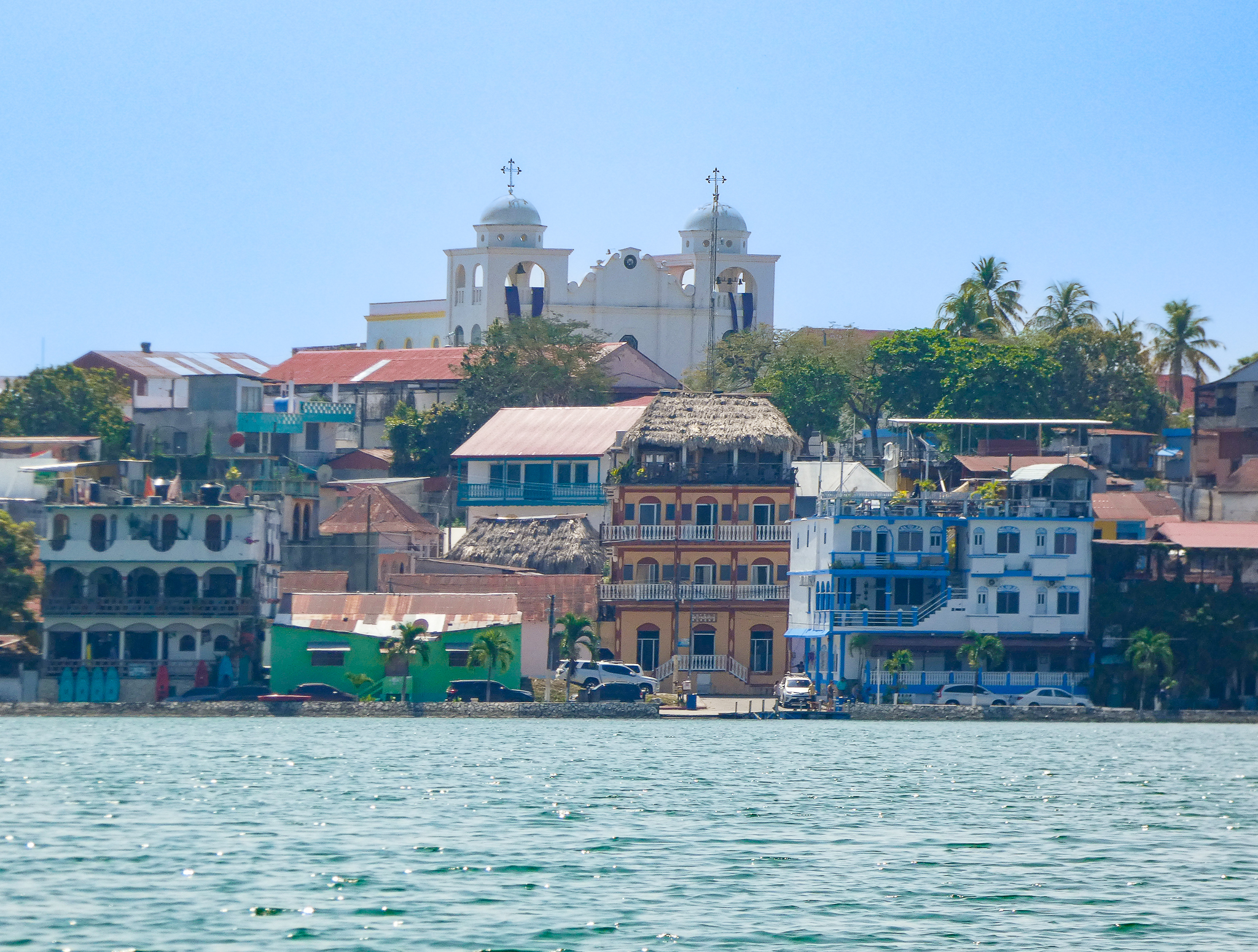
Drums and palms
After dinner, I was walking to my hospedaje (guesthouse) when I heard a sound of trumpets accompanied by a slow beat of drums. I walked into the street from where it emanated and there, I saw fifteen men carrying a float on their shoulders. Behind them was a band, followed by locals. The procession had started from that white church at the top of the street.
On the float stood a life-like, painted statue of Jesus, dressed in pure white. The float was adorned with branches of palm trees, one of them held by Jesus himself. I had never been baptized, so only that sight reminded me it was Palm Sunday, the beginning of the Easter week (Semana Santa).
The men carrying the float were dressed in jeans and plain shirts, which gave the event a low-key appearance. It was a small-town procession for the locals, not a big spectacle for tourists. Still, it created an Easter ambiance that would follow me for the rest of the trip.
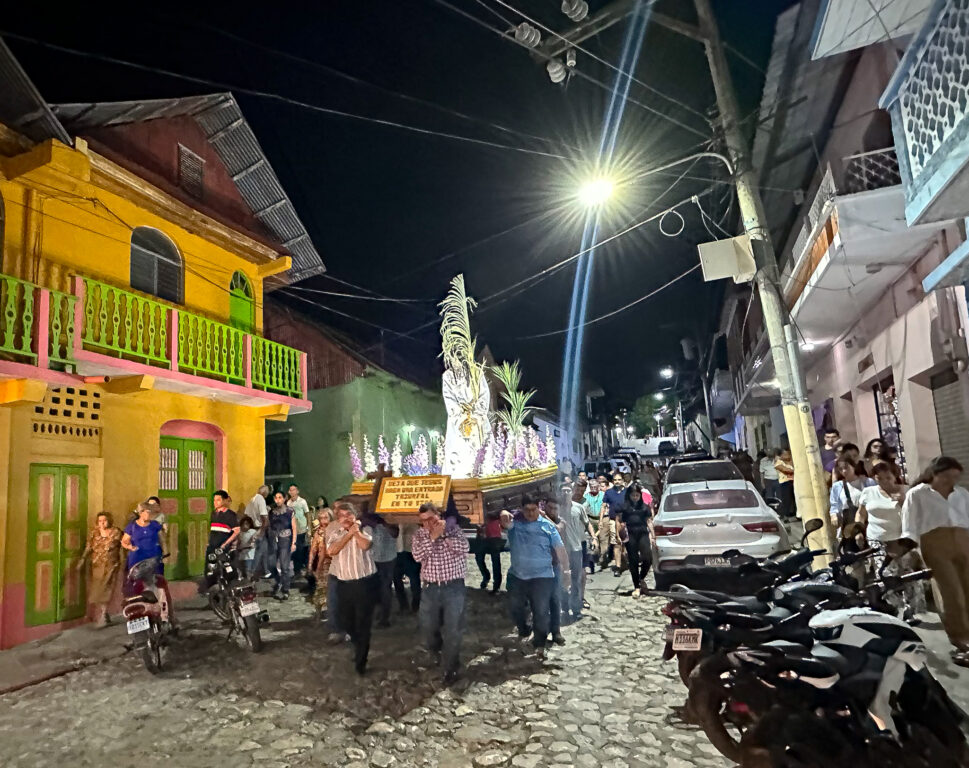
Colonial baroque, standing and gone
I continued my travels and made my way to the town of Antigua, which lies in the country’s heartland, about two hours from Guatemala City by road. Antigua was founded in 1542, and for a few centuries, it served as the capital of the Spanish colony in Central America. As a result, it received abundance of splendid and colorful buildings — churches, convents, palaces, and casas (aristocratic houses). Despite being such an architectural gem, the town feels cozy and inviting rather than grand and showy.
Antigua is visually stunning also because it lies in a valley guarded by gigantic volcanoes — Volcán de Agua being the most prominent one. These landscapes looked so different from the thick jungles of Petén. The climate felt different too; at Antigua’s elevation of fifteen hundred meters (five thousand feet), it was hot, but the humidity was gone.
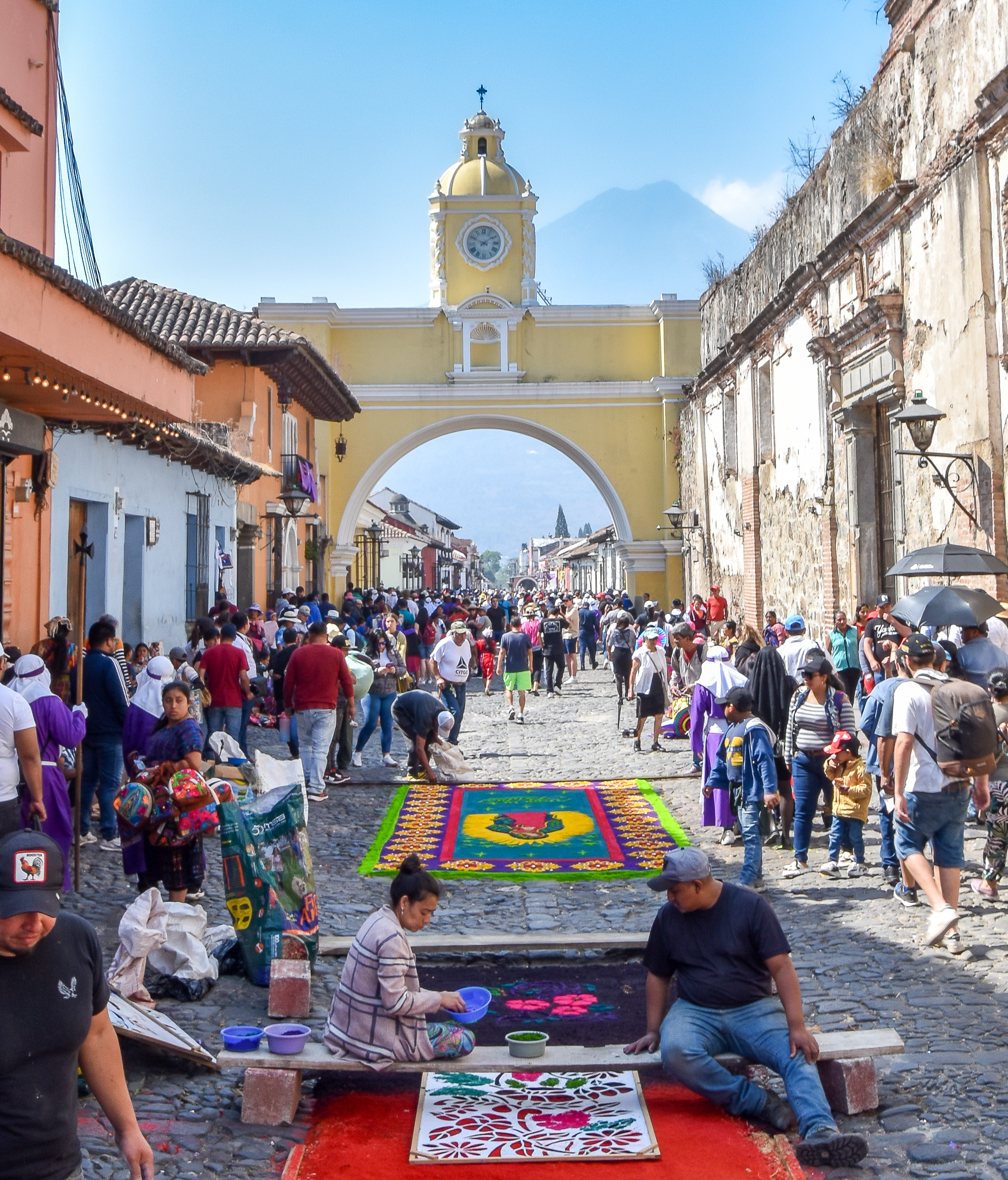
During my stay, I boarded a bus every morning in my village of San Juan del Obispo to go to Antigua. I walked the cobblestone streets there and hiked up to the viewing decks to take in the scenery of Antigua’s old town below and volcanoes around. The two best places to enjoy that view are Cerro de la Cruz, a small hilltop outside the center, and the rooftop of Iglesia de la Merced, a yellow church with a highly refined façade.
The most photogenic place in Antigua is, however, Arco de Santa Catalina — an arch spanning an old street that leads toward Volcán de Agua, best seen very early before the crowds take over.
Apart from the colorful streets and the famous arch, Antigua has one more kind of a unique sight. I found it when I walked from Parque Central past Catedral de San José. The white front of the current cathedral is built in the colonial style, but hidden behind it are the ruins of the original, much larger Catholic shrine. I walked among the bare walls and cracked columns that supported only the outline of the once-vaulted roof. The old cathedral was reduced to its essence, and it felt magical, almost like exploring an ancient Mayan temple. The culprit of the original cathedral’s destruction was, not surprisingly, a series of earthquakes that are still so common in this volcanic valley.
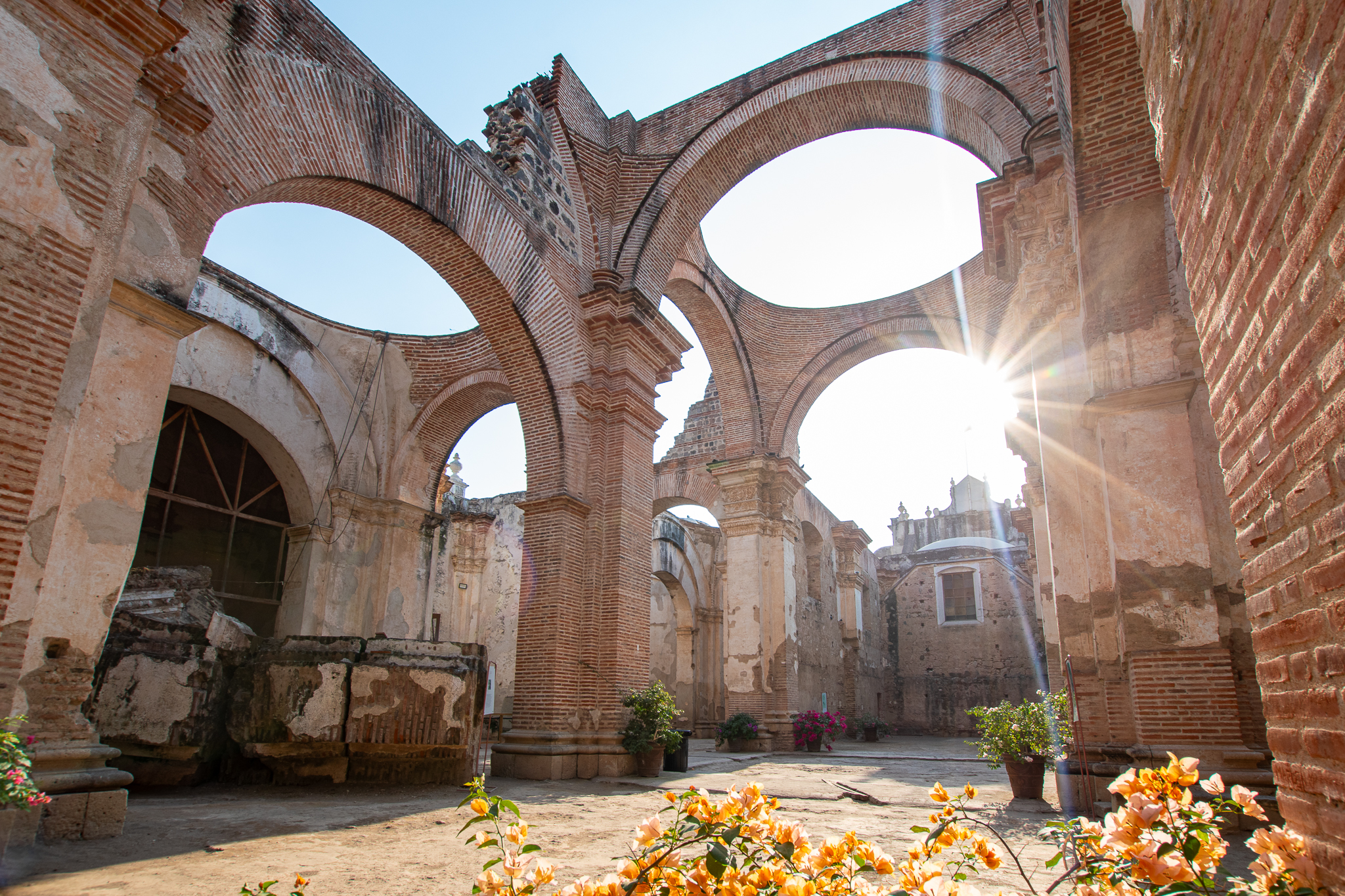
The busiest week of the year
Among the remnants of the cathedral, I came across a crew repainting a long wooden platform. I approached one of the men, and asked, in my rudimentary Spanish, what it was for. “That’s the float for the Friday procession, so we have to finish in two days,” he said and returned to painting the wood around number 55. I realized the number was a marker for a position assigned to a specific float-bearer. Unlike the float in Flores, this one would be so big that the logistics of the procession had to be planned carefully.
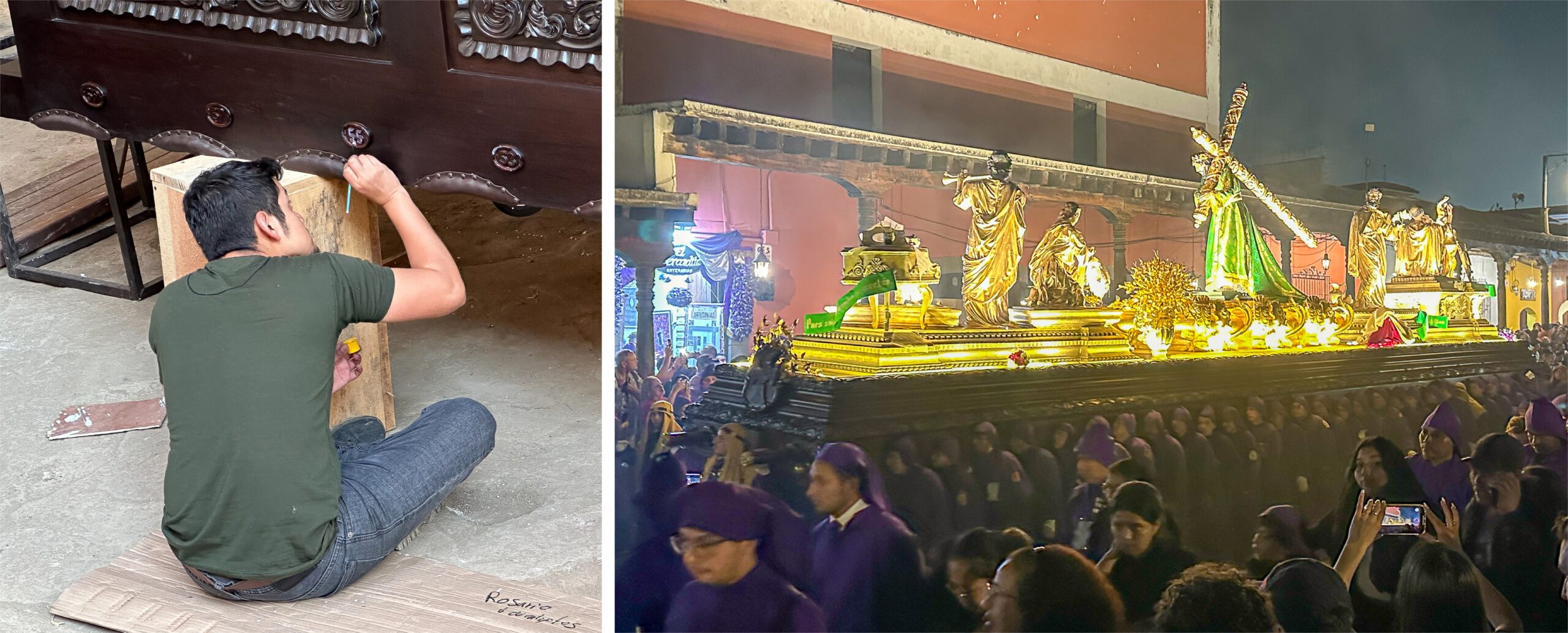
While roaming the streets toward evening, I noticed men dressed in purple cloaks. Later, when darkness fell, large crowds emerged behind railings in Parque Central. They came to see a procession, and I joined them. We watched dozens of the men in purple cloaks, moving in sync, swaying forward and sideways, carrying a long float with a stunning piece of Catholic art — Jesus in green, a gold cross on his shoulder, surrounded by gilded sculptures. Even though the bearers were numerous, they carried a load that looked so heavy for them.
The float was lit up to almost a blinding effect, and the gold shone easily through the cloud of incense. Behind the float marched a huge band of bow-tied musicians, who set the pace for the bearers. The entire procession was honed to perfection.
I learned that what I had just witnessed was Wednesday’s procession of Jesús Nazareno del Milagro, under the banner of the church Santuario San Felipe de Jesús. Almost every day of the Easter week, Antigua hosts several processions, each of which moves along a predefined route through the grid of the old streets. Each procession is organized by a church and its brotherhood (fraternidad) or sisterhood (hermandad). Most incredibly, a procession may last up to twelve hours! The planning of the routes must be meticulous to ensure individual bearers know their spots and two different processions do not collide.

Good Friday artists
Easter processions have a long tradition in Spanish-speaking countries, and Spain itself is famous for them. When I arrived in Antigua on Friday morning, I came across another Spanish-born tradition, which, however, evolved into its most colorful variation here, in Guatemala.
On the cobblestones of a street at the edge of the old town, people were creating works of art known as alfombras or carpets. They indeed resembled runner carpets in their shape and design. I stopped at one of them to observe. The young artist held a large cardboard piece, which had carveouts of various floral shapes in it. He carefully placed the cardboard just above the cobblestones and sprinkled purple-colored sawdust through it. Then, he took another cardboard and did the same with yellow sawdust. The carpet was coming to life, elegantly arranged in regular patterns.
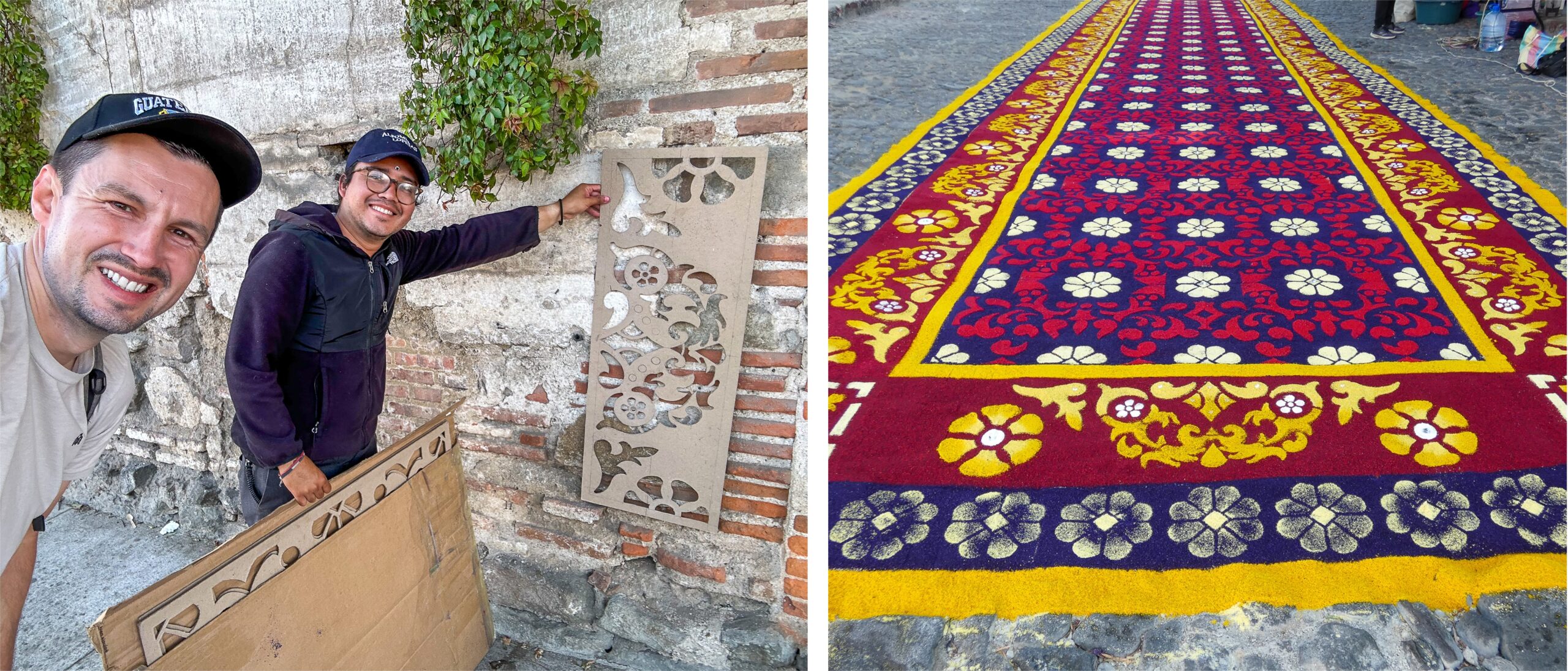
The artist and his group had plenty of buckets of sawdust to choose from, each in a unique, vivid color. I was curious who they were, so I began to talk to him. His name was José, and he said: “I am from a village nearby. But I work here with this art studio,” showing me his phone, where he opened the social-media page of Alfombras López. After he fielded all my questions, José was kind enough to give me two little sacks of sawdust as souvenirs.
I was making my way through the center of Antigua and could not recognize it. Cars, buses, and moto-taxis were gone. All the streets were reserved for the creators of alfombras. I had no way to count them, but I thought there could be a hundred of them.
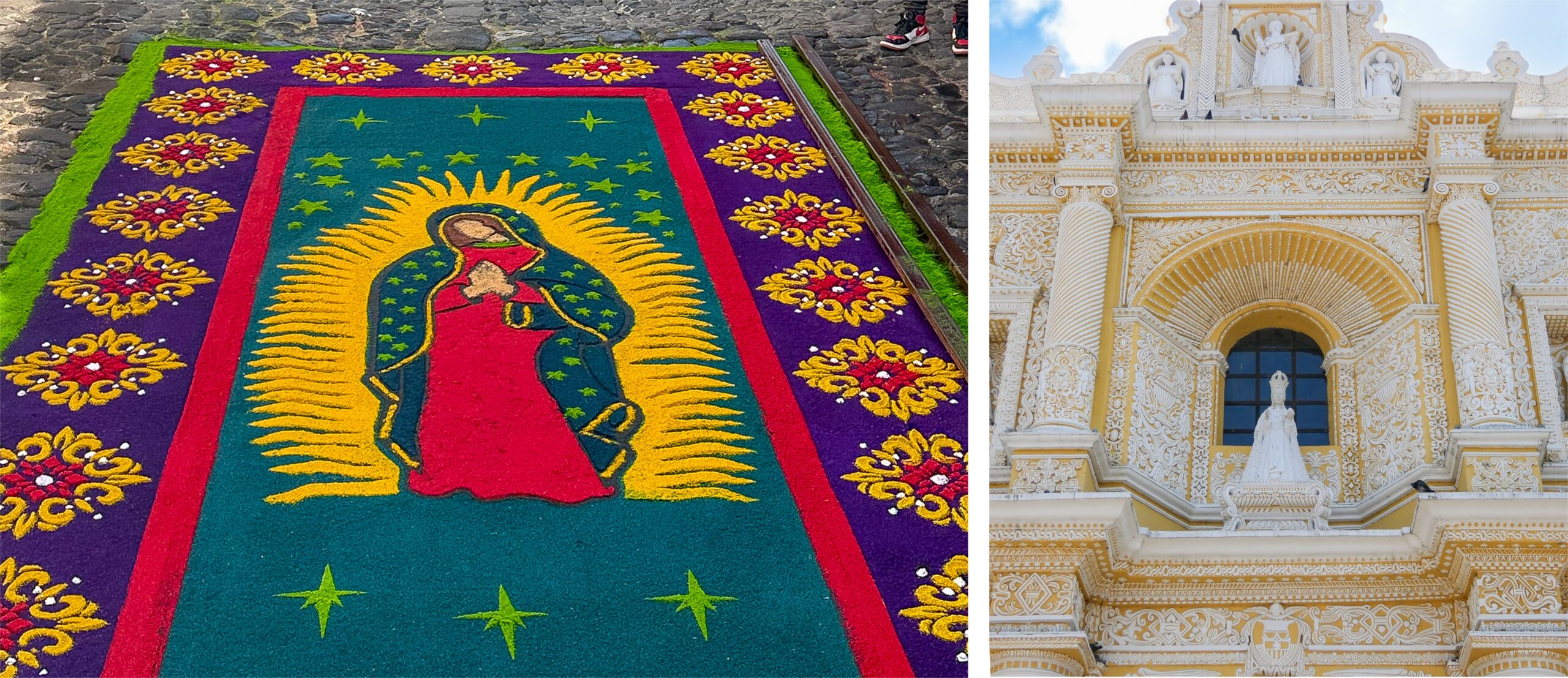
The alfombras close to Arco de Santa Catalina were surrounded by crowds. The themes in them ranged broader and wider as I kept walking. One of the alfombras contained such intricate patterns that I wondered if the façade of Iglesia de la Merced was the inspiration.
Then, I saw a gentleman lying on a plank right above the street level, making a portrait of a big red bird. Another alfombra had a purple Virgin Mary in its center. Sawdust was not the only material used to make alfombras; some of them included petals and green branches. The cobblestones of Antigua morphed into an open-air gallery. Just the sight of it made the whole Easter trip worth it.
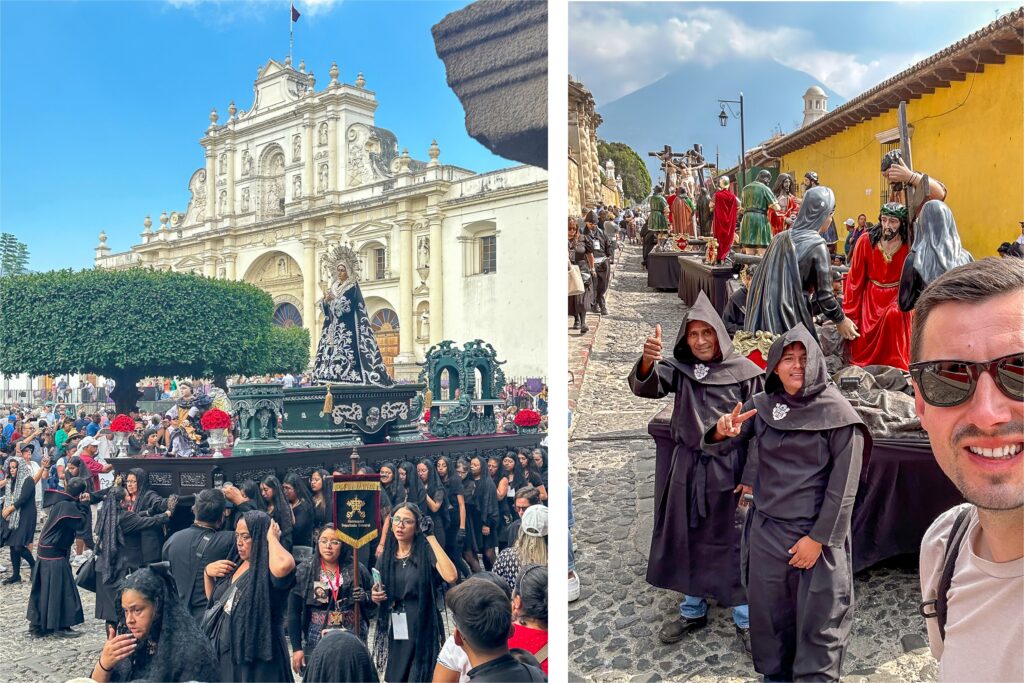
The longest of the processions
My walk among the alfombras took me to Parque Central. There, the crowd gathered for an afternoon procession, which just left the cathedral. Immediately, I recognized the float I had seen the workers preparing among the old cathedral ruins back on Wednesday.
Soon, another float made its way. A statue of Virgin Mary stood on top, and it was carried only by females, all of them dressed in black, including black veils. The afternoon heat must have made the procession an intense physical experience. A woman at the front carried an embroidered banner, which read “Hermandad Sepultado Catedral,” referring to the cathedral sorority that honors the entombment of Jesus.
I continued walking and came across other floats in a side street. These ones were sitting on the ground, arranged in a long train, ready to be moved in a procession later. Each of them represented one of the fourteen stations of the cross, lively and colorfully depicted using painted sculptures. There was so much buzz around them, so I asked one man leaning on a float what kind of procession that would be. He pointed to the emblem on his cloak, with the letters “EC” in it. “We are from Escuela de Cristo.” That was the procession I had heard locals talking about most!
At night, I met this train of floats, slowly rolling through the streets of Antigua, pulled by the men in the “EC” cloaks. The length of the procession was overwhelming indeed. Lights on the platforms emphasized the colors of the statues, and the awe effect was complete.
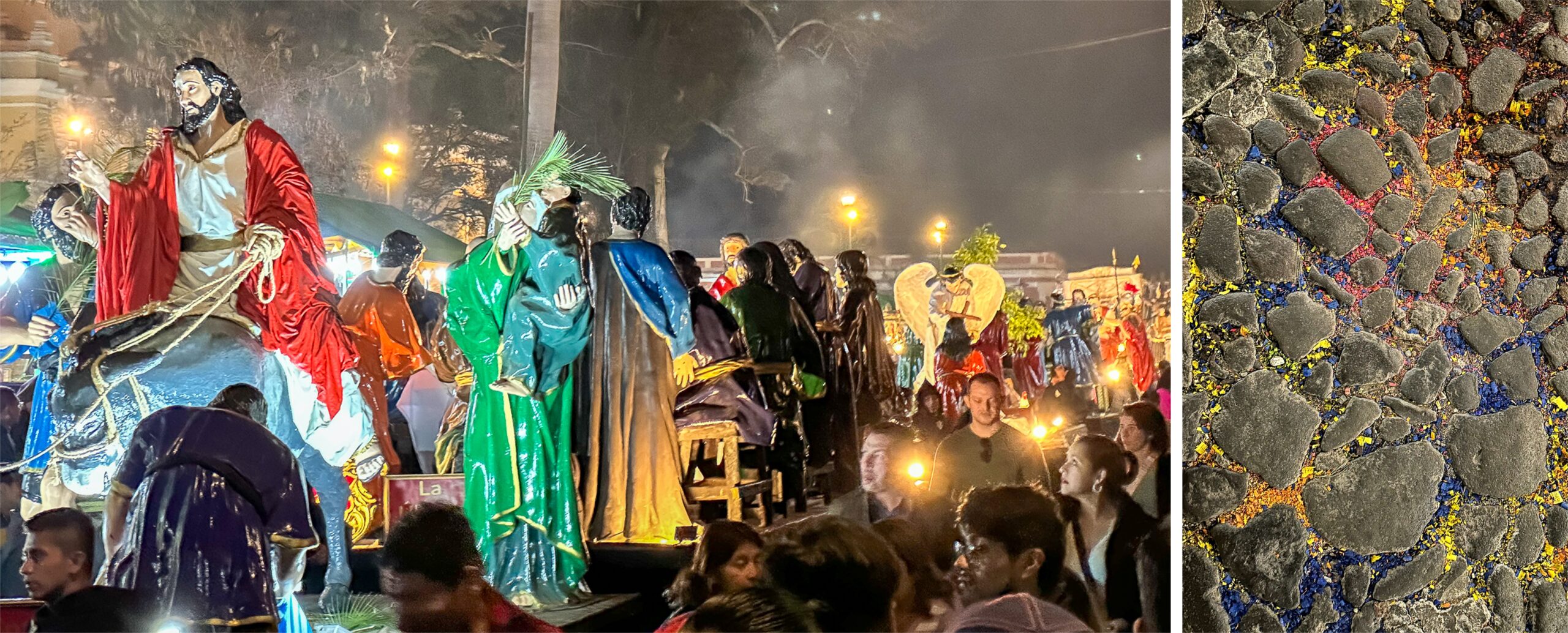
In what was the climax of the week, the Escuela de Cristo procession walked and trampled over the alfombras on the streets. Behind them, they left colorful sawdust just scattered among the cobblestones. The day of crucifixion was commemorated by destroying the art gallery that was so full of life.
Singing by the lake
I thought that Easter in Guatemala had ended for me, but then, I got to see one more event that stirred my emotions; this one at Lake Atitlán. The lake is reached by a three-hour drive from Antigua, so it is possible to make it a long-ish day trip. At the shore of the lake, I jumped on a boat that ferried me to the village of San Juan La Laguna. There, as in other villages around the lake, Mayan communities preserve their ancestral culture, like weaving. They also speak their original languages, along with Spanish.
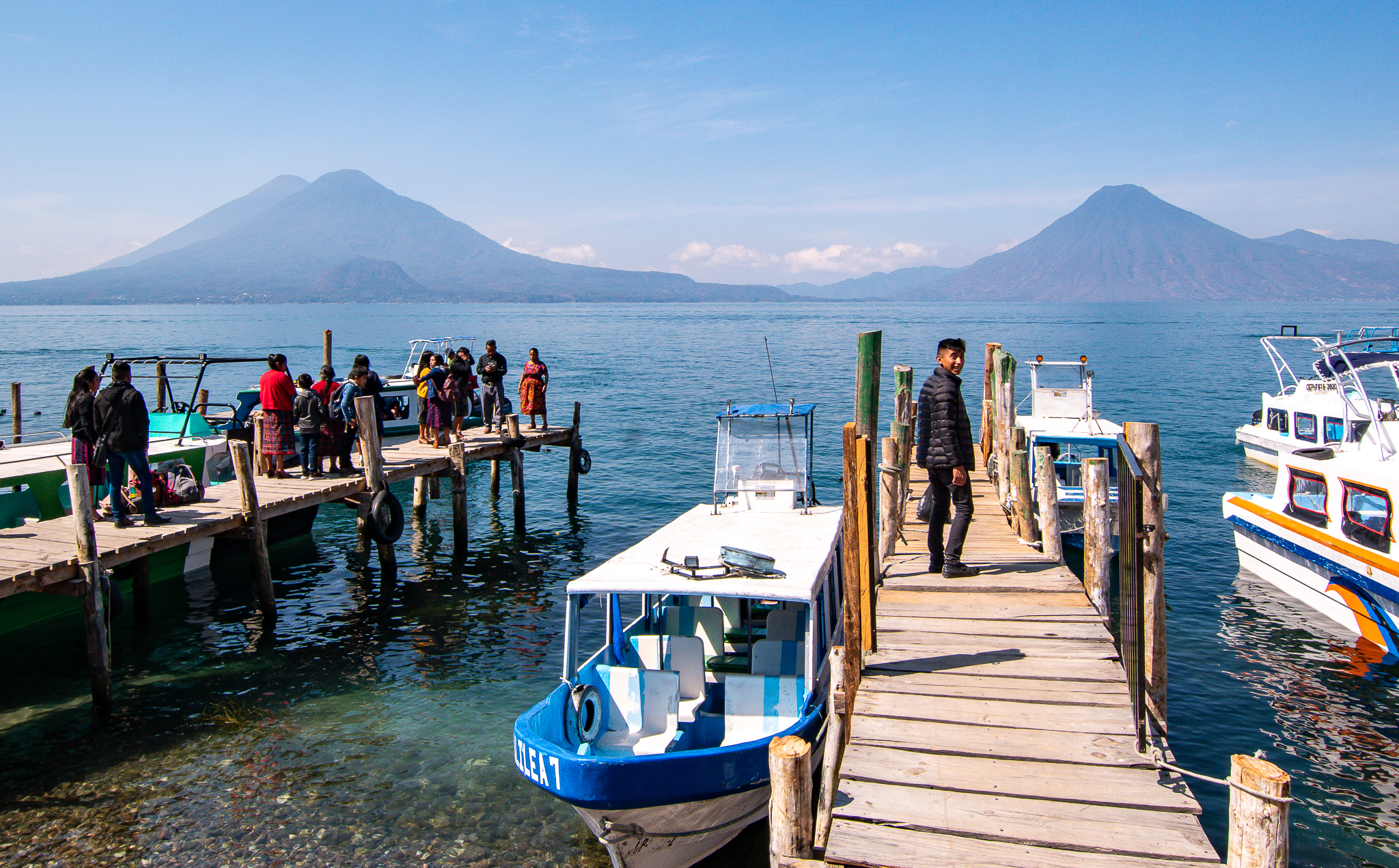
I hiked outside San Juan La Laguna and reached a hilltop, which overlooked the perfectly blue lake with volcanos surrounding it. Then, I walked down a street in the village and heard singing getting closer and closer to me. I knew what it meant. Around the corner, a procession was walking toward me. At the front were teenagers in their red-and-white church robes. They were followed by statues of Jesus and Mary on floats that were swaying above the crowd of men and women. The men were dressed in black suits, white shirts, and hats. The women, on the other hand, stood out with their skirts and scarves made from traditional Mayan textiles, woven with brightly colored stripes and geometric patterns.
The procession did not captivate me only with its colors; it was the sound that made me stop and pay attention. There was no band, only one accordion to lead the melody. The rest of the music was taken care of by the participants, who sang along to a beautiful tune in Spanish: “La luz de Dios, en Él brilló, la nueva vida nos llevó. Alegría y paz, hermanos, que el Señor resucitó.” (“The light of God shone in Him, he brought us new life. Joy and peace, brothers, for the Lord has risen.”). Without any ostentatious show of emotions, their folk-style singing came across as upbeat and heartfelt. I did not see other spectators watching; it was a purely local event. This procession was beautiful precisely for its sincerity and plainness — so much so that it overpowered me more than any other I had observed in the country.
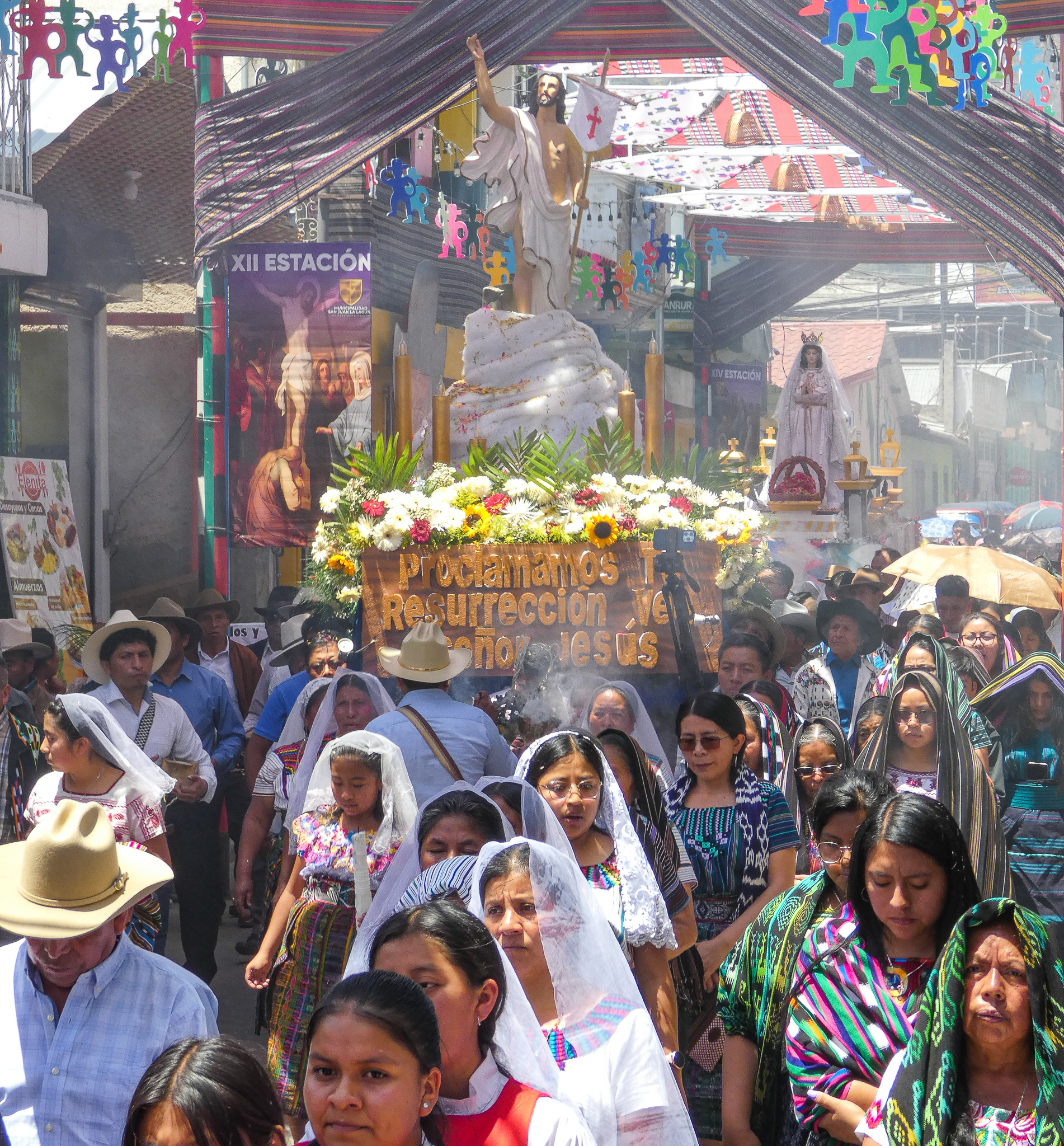
Once the procession disappeared, I had to go back to Antigua. The week was ending anyways, and I was about to leave Guatemala. With all the events I had a chance to see in the country that week, in addition to the archeological sites, volcanoes, lakes, colorful towns and villages, I will never ponder again whether spending Easter in Guatemala is too ordinary of a trip.
If you go
Petén… Low-key guesthouse in Flores: Hospedaje Doña Gladys https://www.booking.com/hotel/gt/hospedaje-dona-gladys-flores-https-www-booking-com-pulse-j1l5ut.es.html; Tour companies for Mayan archeological sites: Tikal Adventures https://tikaladventures.com/?lang=en and Guat2Do Travel Experiences https://guat2do.com/
Antigua… Private shuttle from Guatemala City to Antigua: https://authenticguatemala.com/en/; Cabin in San Juan del Obispo: Casa Jardin De Julia https://casajardindejulia.com/; Cathedral of San José: https://laantiguaguatemala.com/en/monumentos/san-jose-cathedral/; Iglesia la Merced: https://www.vidaantigua.com/attractions/iglesia-la-merced/; Cerro de la Cruz: https://www.vidaantigua.com/attractions/cerro-de-la-cruz/; List of Easter processions: https://www.guatemala.com/noticias/cultura/procesiones-de-semana-santa-en-antigua-guatemala-2024.html; Tour company for the day trip to Lake Atitlán: https://www.grayline.com/tours/panajachel-and-lake-atitlan-tour-with-boat-to-santiago-full-day-from-antigua/
This article was previously published on TravelExaminer.net, where you can view dozens of award-winning national and international travel destination articles.
